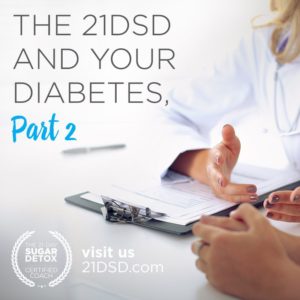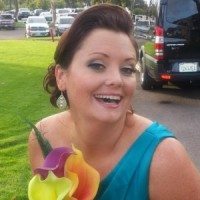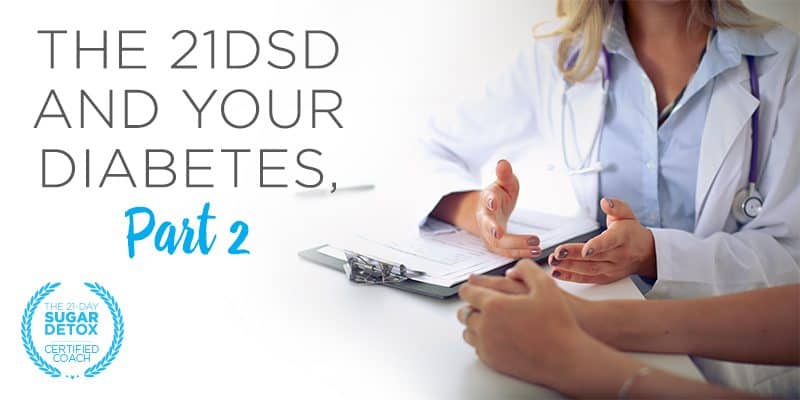Hey Folks! We're excited to welcome back Certified 21DSD Coach Natalie Washabaugh. Natalie's article is part of a series contributed by our Certified 21DSD Coaches. Enjoy! – Diane and Team
**Remember that this information for general information only and is not to be considered professional medical advice, diagnosis, or treatment. Please consult your doctor for personal medical advice.
In my previous blog post, The 21DSD and Your Diabetes, Part 1, I briefly described my journey to health as a type 1 diabetic utilizing the 21-Day Sugar Detox as my guide. I also went over some staggering statistics and definitions that will be useful when reading over the tips below, created to ensure a successful 21DSD. If you missed Part 1, check it out here! Continue reading for useful tips that will guide you through your 21DSD with diabetes.
Consult your doctor
Whether you are working with an endocrinologist or your primary care physician to manage your diabetes, it is important to speak with someone about any dietary or lifestyle changes you may be making. Any changes will have a direct impact on your blood sugar levels and medication needs. Read through the 21DSD Guidebook thoroughly so you are able to address any questions or concerns your doctor may have. Talk to him/her about recovery strategies you will use to combat any low blood sugars (more on this in Part 3!).
Ask your doctor if you can follow-up with him/her or a nurse practitioner during the next 21 days in case something comes up in regards to your blood sugar levels and medication. It is important to keep your doctor informed so that if needed, you can make medication adjustments via phone or email without having to schedule an additional appointment.
While many people feel their doctor is the last word when it comes to health, I firmly believe that because I am living in this body, my personal knowledge oftentimes plays just as important a role as their education. The dietary recommendations that are given for diabetics, both type 1 and type 2, have not changed much since my diagnosis in 1987! I diligently followed the recommendations, struggling with blood sugar spikes and crashes after every meal. I did not get to a place of balanced blood sugars until I started listening to my body and removed foods that were recommended to treat my disease.
Deciding to start a 21DSD means you are ready for a change and motivated to understand your body. And I would argue that the only person who can truly understand your body is YOU. Doctors should be teaching you how your body works within the parameters of your new lifestyle and advise you about signs and symptoms to look out for as you transition to a healthier way of life. Your doctor should be a part of a team that centers around you and includes you, with the ultimate goal of keeping you healthy. Going into this appointment armed with your own research and personal experience will allow you to advocate for yourself and your disease.
Test, test, test
 Because any changes to your diet will have a direct impact on your blood sugar levels and medication needs, it is important that you are testing as often as possible, pre- and post-prandial (meal) to ensure that you are staying on top of unexpected highs and lows. Both high blood sugars (hyperglycemia) and low blood sugars (hypoglycemia) will more likely come from incorrect carbohydrate counting and incorrect insulin (medication) dosing.
Because any changes to your diet will have a direct impact on your blood sugar levels and medication needs, it is important that you are testing as often as possible, pre- and post-prandial (meal) to ensure that you are staying on top of unexpected highs and lows. Both high blood sugars (hyperglycemia) and low blood sugars (hypoglycemia) will more likely come from incorrect carbohydrate counting and incorrect insulin (medication) dosing.
I currently use an insulin pump (a small computerized device that delivers insulin through a port in the body) and Continuous Glucose Monitor (CGM-a sensor inserted in the body to constantly track glucose levels) to manage my diabetes. I still test 5-7 times per day even though I utilize some advanced technology to help me track my blood sugar levels.
A typical day of testing on the 21DSD looks something like this:
- upon waking,
- pre-breakfast, 2 hours post-breakfast,
- pre-lunch, 2 hours post-lunch,
- pre-afternoon snack (if one is consumed),
- pre-dinner, post-dinner
- and before bedtime.
While that may seem excessive to some, testing this often allows me to closely monitor my blood sugar levels and the impact of my meals, exercise and even stress. I am also able to track my insulin needs more closely and adjust accordingly.
Adjust medication as needed
The 21DSD is not necessarily a low-carb approach, but if you are transitioning from a Standard American Diet (SAD) you will more than likely end up consuming fewer carbohydrates because you will be removing the highly processed culprits from your diet. This means you will require less medication, either injected insulin or oral medication.
For those type 1 diabetics and type 2 insulin dependent, it is important you understand your insulin to carbohydrate ratios (how many units of insulin per grams of carbs are needed) to medicate properly. A ratio of 1:10 means that for every 10 grams of carbohydrate they eat, a person needs to inject 1 unit of rapid or short-acting insulin. Your doctor can help you find the carb-to-insulin ratio that is right for you.
Transitioning to a whole-food diet means eliminating processed, packaged foods. This also means ditching food labels. This can make calculating your carbohydrate intake a bit difficult. There are tons of wonderful online resources available to educate you on carbohydrate counts for specific serving sizes. I keep a pocket sized book from Calorie King in my kitchen to help me calculate the total carbohydrates for each meal. If you are finding 21DSD-approved recipes online, search for ones that also post nutritional information to make your calculating easier.
You can also calculate carbohydrate totals for recipes by finding the total carb count for each ingredient, then dividing the total by the serving size listed in the recipe. I have gone through most of my cookbooks and written the carbohydrate totals for a quick reference when needed. Eventually this will become second nature and you will be able to look at a 1 cup serving of broccoli and know it contains about 5 grams of carbs.
**If you are managing your diabetes through insulin pump therapy or injecting long-lasting insulin, I recommend you assess your basal rates prior to starting a 21DSD. If you are unfamiliar with this process or need a refresher I found a wonderful resource for you here!
Click here for Part 3 of The 21DSD and Your Diabetes which will include more helpful tips to ensure success as a diabetic on a 21DSD.
 Natalie Washabaugh M.A. is a Nutritional Therapy Practitioner (NTP) and a 21-Day Sugar Detox Coach focusing on fat loss, blood sugar regulation, body image issues and healing relationships with food, all issues she has personally struggled with as a Type 1 diabetic of 30 years. She loves educating clients on simple mindset shifts, nutrition myths and movement, providing them the tools necessary to nourish themselves mind, body and soul. She is also a certified American Sign Language (ASL) interpreter who strives to bring health and wellness directly to the Deaf community. She enjoys lifting heavy, San Diego sunsets and walking her two puggles, Max and Rambo, on the sandy shores. You can find her blogging sarcastically on her website, Instagram, Twitter and Facebook.
Natalie Washabaugh M.A. is a Nutritional Therapy Practitioner (NTP) and a 21-Day Sugar Detox Coach focusing on fat loss, blood sugar regulation, body image issues and healing relationships with food, all issues she has personally struggled with as a Type 1 diabetic of 30 years. She loves educating clients on simple mindset shifts, nutrition myths and movement, providing them the tools necessary to nourish themselves mind, body and soul. She is also a certified American Sign Language (ASL) interpreter who strives to bring health and wellness directly to the Deaf community. She enjoys lifting heavy, San Diego sunsets and walking her two puggles, Max and Rambo, on the sandy shores. You can find her blogging sarcastically on her website, Instagram, Twitter and Facebook.


Comments 1
Pingback: Summer Farmers Markets | What's Up Weekly with Diane | May 24th, 2017